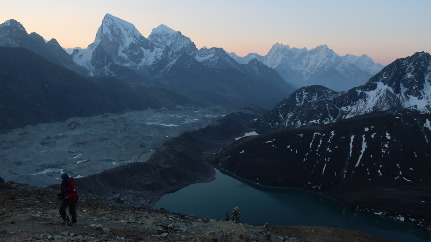Nepal, close to 100 km
This track is the second most popular of the easy tracks around Mount Everest in Nepal. The most popular track by far is the visit to the Everest Base Camp, the so-called "EBC trek." Our route is advantageous compared to the EBC trek because it lacks crowds of people on the trail. As the most popular in the region, the EBC trek naturally attracts the maximum number of tourists, and it is not uncommon to see real queues on the trail, which are sometimes exacerbated by caravans of donkeys and yaks. We, on the other hand, literally on the third day of the hike, turn off from the main "highway" and begin to enjoy the solitude in the mountains.
In brief about the route
The main attractions include the Hillary Airport in Lukla, the Sherpa capital of Namche Bazaar, Buddhist stupas along the trail, mani walls, Buddhist monasteries, the longest glacier in the Everest region - the Ngozumpa glacier, views of the eight-thousanders Cho Oyu, Everest, Lhotse, and Makalu. And of course - the highlight - the Gokyo Lakes. There are 5 of them, and it is relatively easy to visit 4. The furthest one requires a separate full day. It is worth noting separately the ascent to the peak of Gokyo, which is 5350 meters high, at dawn: if you are lucky with the weather, the views of Everest and other surrounding peaks are breathtaking! Our route is circular, so to avoid going down the same road, we will cross the Renjo La pass at an altitude of 5350 meters and descend back to Namche Bazaar through the neighboring valley, not forgetting to visit a couple of ancient Buddhist monasteries on the way.
Local features
- Nepal, Khumbu region, Sagarmatha National Park.
- The route starts in Lukla, at an altitude of 2800 meters, and the highest point of the route is 5350 meters - the Gokyo peak and the Renjo La pass.
- A permit is required to visit the park, and it can be purchased on-site. TIMS (Trekkers' Information Management System) registration is also required and can be done on-site.
- All overnight stays are in local lodges, which are usually very simple hostels. Toilets may be located outside, although this is becoming less common in recent times. Hot water above Namche Bazaar is considered a luxury and may require an additional small fee to purchase.
Season
There are two high seasons in a year - April-May and October-November. It can be confidently said that from June to mid-September, or even the end of September, it is better not to come here as it is rainy and cloudy. Beautiful views are likely to be seen only in the drops of rain on the leaves of trees. In contrast, the winter months, namely December-January and February-March, are more positive in terms of weather, but, logically, colder. I would recommend December as one of the statistically driest months, but you need to be prepared for cold nights and evenings.
Home long does it takes
From Lukla to Lukla, I would budget for 2 weeks with a couple of extra days in case of bad weather, as flying back in bad weather is unlikely. These 2 weeks include a rest day for acclimatization in Namche Bazaar and a separate day for Gokyo Peak. In my opinion, this will allow you to be more flexible if you need to change something during the trek.
After arriving in Kathmandu, it is possible, and I would even say better, to fly to Lukla the next morning. However, on the return trip, it's worth leaving a couple of days in Kathmandu to leisurely explore the city and be assured that in case of bad weather, you will have enough time to travel from Lukla to Kathmandu by land transport.
Map
Distance: kilometer Elevation (loss): meter Elevation (gain): meter
Gallery


